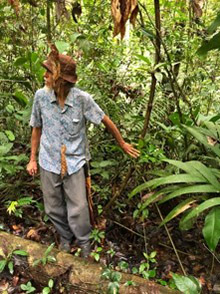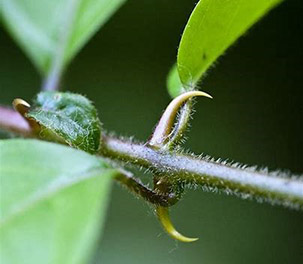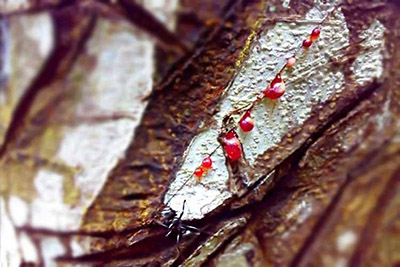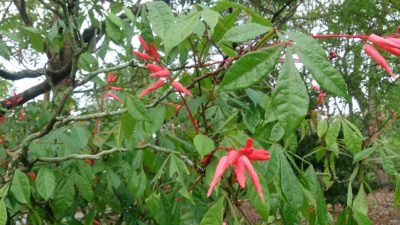
Michael Tierra and a toucan in Costa Rica
On our recent second visit to Costa Rica, we re-experienced the wondrous biodiversity of its plants, exotic wildlife, volcanoes, and hot springs but also a rare insight into its traditional healing customs.
With the assistance of an interpreter, this information was provided by our guide, the distinguished native ethnobotanist, Rafael (Raffi) Angel Ocampo Sanchez. Raffi, is the creator and keeper of Sacred Seeds Sanctuary at Finca Luna Nueva.
Most visitors and tourists visiting Costa Rica only experience the influence of the many expatriates from around the world, most of whom are from North and South America. They are hardly ever aware that there are still remaining eight indigenous tribal reservations that continue to practice and preserve the old ways.
Raffi told us how there are generally two classes of traditional healers: the shamans and “grandmothers.” As with most tribal cultures, the emphasis is on the treatment of injuries, trauma, and GI tract disorders such as diarrhea, dysentery and parasites. This is not to say they do not treat other conditions such as infections and inflammation, nervous complaints, arthritic conditions, gynecological disorders, and insomnia.
We learned that so many of the plants (especially tree barks) are used to treat diseases like diarrhea and dysentery. Most of these are handled in the village by “grandmother” herbalists who know what plants to use for each of these, evidently with a high degree of success. More complex problems, especially psychosomatic conditions, are attended by the shamans who include ceremony and ritual as part of their healing.
Certain boys are selected at an early age to apprentice for several years with a shaman. The early stages of this training consists of following the shaman through the jungles where they are encouraged to taste the plants, learn about their potency, the optimum places and time for harvesting, and so on. The shaman is entrusted with the deep spiritual wisdom regarding people’s relationship to the earth and especially to the jungle as a place where life is continually reborn.
People living in or close to the jungle consider its wild biodiversity, the likes of which surpass what is familiar in cities and more temperate climates in North America, as essential to all life. Indeed, Costa Rica is home to 50 different species of hummingbirds while there are only 12 in the US; and 1250 different species of butterflies compared to 750 in the United States, which occupies a space 192 times bigger than Costa Rica. Of course, all people, whether they know it or not, have a special relationship with the abundance of different plants and trees which are used for many practical purposes including food and medicinal uses.
We learned of dozens of herbs and trees, but I focus here on three botanicals native to the jungles of Costa Rica that are also available in the North America.

Raffi points out a climbing tendril of cat’s claw.
Cat’s Claw
Cat’s claw is broadly used as a potent anti-inflammatory for the treatment of rheumatic conditions, arthritis, bursitis, lupus, Lyme disease, diabetes, and cancer. Western herbalists especially use it for inflammatory GI conditions such as ulcerative colitis, IBS and Crohn’s disease.[1] Cat’s claw is claimed to have both immune-stimulating but more importantly, immunomodulating properties. As a result, there is some confusion as to whether the immune stimulating properties might be contraindicated for certain autoimmune diseases, especially multiple sclerosis. Because of its cooling, detoxifying, anti-inflammatory properties, Cat’s claw is more immune-modulating, meaning that it removes toxins without causing an overreaction than immune stimulating herbs might. However, to counteract any possible adverse autoimmune effects from cat’s claw one may choose to take it with well-known immunomodulating herbs such cordyceps[2] or chaga[3] These contain polysaccharides, or essential sugars which have been shown to modify and calm a chaotic immune system. However, in most cases this may not be necessary.
Cat’s Claw for Cancer
As an anti-inflammatory, cat’s claw contains a pentacyclic oxindolic alkaloid which has exerted anti-inflammatory effects by blocking the body’s production of inflammation-producing substances such as tumor necrosis factor-alpha (TNF-alpha). This substantiates its well-documented benefit for treating all types of cancers.

The thorn, or claw, of cat’s claw
Cat’s Claw for Hypertension and “Liver Wind”
Cat’s claw may also have a special benefit for hypertension and certain neurological conditions and diseases such as dizziness, vertigo, chorea and Parkinson’s. Another species of cat’s claw used in traditional Chinese medicine (TCM), called gou teng (Uncaria rhynchophylla) is used for internal “Liver Wind” conditions and diseases described above. Because both South American cat’s claw (Uncaria tomentosa) and gou teng contain the alkaloid, rhynchophylline,[4] South American and Costa Rican cat’s Claw may have properties in addition to anti-inflammatory and may be considered as an alternative to Chinese gou teng. One important difference between the two, however, is that the inner bark of the vine or the root of South American/Costa Rican cat’s claw is used while it is only the thorn or “claw” of gou teng that is used.
Cat’s Claw and Kratom
More recently, it has been found that a normal dose of cat’s claw taken about 45 minutes before taking the pain-relieving herb kratom (Mitragyna speciosa) potentiates the effects of the latter. Kratom, like cannabis, is used both recreationally as a psychoactive herb as well as an herbal alternative to opioids for relieving intractable pain. Kratom and both species of cat’s claw contain rhynchophylline and other alkaloids, which may explain why one potentiates the other. Kratom is also anti-inflammatory, and both having different pain-relieving properties, there would be a synergistic positive aspect with the two taken in proximity with each other. Any possible negative effects would be negligible.

The blood-red exudate that is sangre de drago.
Dragon’s Blood
Dragon’s blood (Daemonorops draco et spp.) is commonly known as sangre de drago or sangre de grado. The more potent Costa Rica species is natively called tarquay. In Chinese, it is called xue jie.
Sangre de drago, meaning “blood of the dragon” in Spanish, is named for its blood-red resin. It has a long history of use by indigenous tribes throughout the Amazon, especially in Peru, Ecuador and Costa Rica. Its common use is to stop bleeding, heal wounds and treat intestinal problems, especially diarrhea and dysentery. It was first referenced by the Spanish explorer P. Bernabe Cobo in the 1600s. Studies conducted in the late 1970s proved its efficacy and it is found in several pharmaceutical products sold throughout South America. If you ever find yourself suffering from dysentery and diarrhea while traveling in tropical countries, dragon’s blood can be a life-saving and possibly face-saving ally. In fact, dragon’s blood taken internally is one of the best remedies for Ulcerative colitis, IBS and Crohn’s disease.
Dragon’s Blood: Superior Wound Healer
Dragon’s blood contains taspine and a proanthocyanidin, both with powerful anti-inflammatory antibacterial and antiviral properties, making it one of our most potent botanical wound healers. Part of the palm family, various species grow in tropical areas throughout the world.
One of our afternoons at Ama Tierra was spent with Doña Zoraida, a respected native medicine woman, who taught us about many of the herbs and common remedies and preparations used by her people. She is one of the “grandmother” herbalist healers of the Quiterrise, which is one of the eight indigenous tribes in Costa Rica. Doña Zoraida did not speak English so that her informal teaching was facilitated by a translator.
Doña Zoraida sells her formulas and extracts at local farmers markets. One she showed and described as most precious was a liquid extract of dragon’s blood known locally as tarquay. It so happens that the preferred and most potent species of dragon’s blood is not the one commonly available commercially in the West, Daemonorops draco, but the more potent Costa Rican species, Croton lecheri. It is more expensive because the extraction of the resin results in the destruction of the tree. This blood-red exudate is highly regarded and used for healing wounds, skin conditions and trauma as well as dysentery and diarrhea. Subsequent research confirmed that the standardized dragon’s blood product SP-303 (Provir) used for diarrhea was effective at doses ranging from of 125 to 500 mg daily.
Besides Amazonia and Costa Rica, dragon’s blood is native to India, Indonesia and Malaysia as well as China and Iran. It is dispensed as a powder or liquid extract and besides its immune-protective, anti-bacterial and anti-viral properties, it is used as an astringent, stopping cuts from bleeding. It is also given to women internally to treat excessive menstrual discharge and bleeding after childbirth. It is extremely effective for non-infectious diarrhea and diarrhea not caused by food poisoning (Crohn’s disease, ulcerative colitis, and IBS). An elderly student herbalist living with a Peruvian indigenous tribe said it was a virtual panacea among all the people in the region. When externally applied it dries and creates its protective covering over a wound. With diarrhea and dysentery being a common disease in the jungle, it is no wonder that dragon’s blood would be the most commonly used remedy.
Dragon’s blood is regarded as the world’s most powerful antioxidant. Researchers took 100 grams of Croton draco exudate powder and tested it against the other plants known to have high antioxidant content. Its Oxygen Radical Absorbance Capacity (ORAC) score was 2,897,110, making it the highest antioxidant food in the world. Its closest competitors are left in the dust as judged by their ORAC values:
- Sumac bran – 312,400
- Ground cloves – 290,283
- Dried amla berries– 261,500
In other words, C. lecheri dragon’s blood tree sap taken internally is at least 800% more powerful than the three antioxidant runner-ups! Just a single drop of dragon’s blood is equivalent to 2 lbs of raw kale or three apples’ worth of antioxidants.
Dragon’s Blood in Traditional Chinese Medicine
One species of dragon’s blood is used in traditional Chinese medicine. It is specially dried and processed and is known as xue jie (Sangusis draconis). It is mainly found and cultivated in Indonesia, Malaysia and Iran, Guangdong and Taiwan provinces and in China. It is described as sweet, salty, neutral, entering the Heart and Liver meridians. Its primary use in TCM is similar: breaks up blood congestion, alleviates pain, stops bleeding, and promotes tissue regeneration. It should be used whenever an analgesic, wound-healing remedy is needed. It combines well with catechu and panax pseudoginseng (san qi or tienchi aka sanqi ginseng) for this purpose. The standard internal TCM dose is 1 to 2 grams of the dried and powdered dragon’s blood ingested one to three times daily.

Quassia amara
Quassia Amara
The last botanical I will briefly mention is Quassia amara, a tree found growing in Costa Rica, parts of South America and Florida. It is commonly known by natives as hombre grande (“big man”) and by Western herbalists as bitterwood. It is the bark or wood, cut in small pieces that is used as a bitter tonic, appetite stimulant and febrifuge. In Costa Rica, it has been used in enemas as an anthelmintic against pinworms for gastric affections, to purify the blood and for intestinal parasites in general. Other uses include treatment for snake bites and diabetes mellitus. In Guatemala, an infusion or maceration of the wood is used as a bitter tonic and febrifuge for diarrhea, dyspepsia, flatulence, gonorrhea, malaria, renal conditions, liver problems, gallstones, and to increase gastric and biliary juices. Similar uses of Quassia extend throughout Central and South America and Europe. In many of these areas as well as in England a water extract of wood is applied against scabies, lice and other cutaneous parasites and as a general insecticide.
Treating internal worms and parasites with Quassia and other antiworm herbs
Quassia is an excellent herb for killing and eliminating internal worms, amoebae and parasites. For such uses one must use it aggressively on a daily basis for one or two weeks at the most, before taking a pause of a week or so. I recommend combining equal parts powdered quassia, golden seal, black walnut hulls and epazote (Dysphania ambrosioides). One should take a teaspoon of the powder four times daily for a week. This can also be taken in “00” sized capsules if preferred. The same combination may be taken as an herbal enema once a day. A few leaves (2 to 4) of epazote can be included in the diet. People in Central America often cook them with beans which assists digestion, and further helps to prevent parasites. After a week to 10 days of this intense treatment, assess progress (don’t be surprised if there is not a dramatic show of worms in the stool during treatment). After a week break, the process should be repeated twice again. It is extremely important to follow a simple bland diet with absolutely no refined foods, especially sugar.
For prevention of worms and parasites and to tone up digestion, one can have a cup of quassia tea once or twice a week. Raffi is acknowledged to be one of the world’s leading experts on quassia. His book Quassia Amara: Bitterwood, cultivation, conservation and commerce is available in English translation printed by United Plant Savers.
Quassia, like many intensely bitter herbs, may cause infertility when taken in higher doses over a long period. This would not be a consideration when used to accomplish a specific objective such as small doses in a bitters formula or for the treatment of worms and parasites.
Quassia is known for its intense bitter flavor, and its intense bitterness is naturally repugnant to most internal and external critters. Its most famous use is as such is an essential ingredient in commercial and home herbal bitters made and sold throughout the world. In Costa Rica, the export of quassia to the world accounts for 40 percent of its total GDP, making it the most valuable export product from the country.
Despite its intensely bitter taste many native people, including Raffi, will drink a cup of quassia wood tea at least once a week and even cultivated a taste for it. In the tropics, intestinal worms and parasites is not rare and as is said, especially if you ever had or know someone with intestinal parasites, “an ounce of prevention in the form of quassia tea is worth a pound of cure.”
[1] https://bit.ly/2T2bG6k
[2] https://bit.ly/2KrAqRJ
[3] https://bit.ly/2rVgZHl
[4] https://bit.ly/2ZGwfYV
